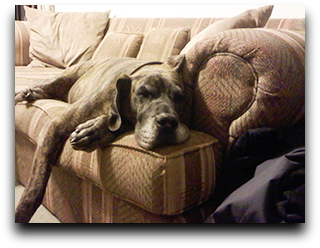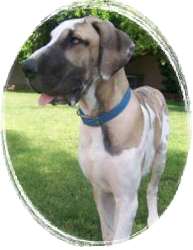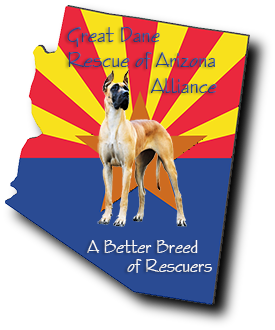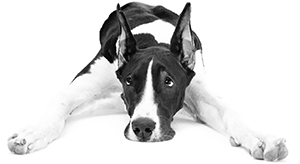
Bloat is a Dane’s worst enemy. Please be sure to feed your Dane 2-3 times a day with smaller meals
instead of one large meal per day. Give them plenty of water. And please make sure that they rest a
full hour before and after their meal. No active play sessions, romps in the yard, walks, or things that
might cause them undue stress. They can certainly go outside to use the restroom, but other than
that, it’s best for them to lie down and relax.
Your Dane may be suffering from bloat if his/her stomach looks swollen, the dog keeps trying to belch
or vomit unsuccessfully, there’s excessive salivation, shortness of breath, cold body temperature, pale
gums, rapid heartbeat, or if the Dane collapses.
If your Dane displays any of the following symptoms, or especially several of these, take your dog to
the vet IMMEDIATELY - their life is in danger. Early detection and medical attention is their only
chance to survive.


(This Dane demonstrates the proper before/after meal posture)


Valley Fever (VF) has become a serious health concern for pets over the past 15 years due to the
population growth & development in AZ. VF is NOT contagious. It is a fungal spore in our soil. Our
vets have seen an alarming increase of cases in their practices.
Your dog could be at risk if you show your dog or travel through an area where VF is prevalent,
including California, New Mexico, Texas, Southern tip of Nevada, and Arizona. The risk arises when
you return home and your local vet is not experienced enough with VF for proper diagnosis. This can
lead to your dog's illness being misdiagnosed, leading to your Dane getting sicker or even dying before
proper treatment is administered.
In most cases, VF is treatable, but it needs a proper diagnosis so the right medicine can be dispensed.
Please take the time to thoroughly research information about VF. This way if your dog is affected, you
will know what to do and what questions to ask your vet.
The site below is a good starting point to learning more about VF:
General Appearance of a Great Dane
The Great Dane’s regal appearance combines dignity, elegance and strength with a large, well-formed, powerful, smoothly muscled body. It is one of
the giant working breeds, but is unique in that its general conformation must be so well balanced that it never appears clumsy, and should move with a
long reach and a powerful drive. A Great Dane must be spirited and courageous, never timid, always friendly and dependable. This combination of
physical and mental characteristics gives the Great Dane the majesty possessed by no other breed.


(Please note that we are not affiliated with the following organizations and are not responsible for the content of their websites.)
• http://www.akc.org/dog-breeds/great-dane
• https://gdca.org
• http://www.animalplanet.com/breed-selector/dog-breeds/working/great-dane.html
• https://www.greatdanelady.com
• http://www.ginnie.com/greatdanes.htm
• http://www.vetstreet.com/dogs/great-dane
• http://www.westminsterkennelclub.org/breedinformation/working/grdane.html
• https://gdca.org
• http://www.animalplanet.com/breed-selector/dog-breeds/working/great-dane.html
• https://www.greatdanelady.com
• http://www.ginnie.com/greatdanes.htm
• http://www.vetstreet.com/dogs/great-dane
• http://www.westminsterkennelclub.org/breedinformation/working/grdane.html



Join us on Facebook

Follow us on
Instagram
■
This technique has been around for a long time and different trainers call it something different! So... what you do is hold the pup like a baby so they are belly up & legs in the air. You do not let the pup loose until it submits and is no longer struggling. We usually give them a nice belly rub as a reward! If your dog is larger, you roll them onto their back on a soft surface, not a tile floor, and keep them belly up til they are calm and have submitted. Lots of praise is important also when they are learning.
■
DO NOT allow the pup to chew on your body parts! We have a saying in the dane world... "what is cute at 25 lbs won't be cute at 125 lbs." And don't give them an old shoe to chew on. They don't know the difference between an old shoe & your new Gucci's!
■
DO NOT play tug of war with a puppy ever. Once they are command trained then you can play tug with your dog! It is considered the most aggressive form of play and in the event you do not win, you lose your position as alpha.
TRAINING A PUPPY

■
This technique has been around for a long time and different trainers call it something different! So... what you do is hold the pup like a baby so they are belly up & legs in the air. You do not let the pup loose until it submits and is no longer struggling. We usually give them a nice belly rub as a reward! If your dog is larger, you roll them onto their back on a soft surface, not a tile floor, and keep them belly up til they are calm and have submitted. Lots of praise is important also when they are learning.
■
One thing many folks do with their dane pup is teach them to give paw. Rescues spend more time teaching them NOT to give paw! It is dangerous with small children as the dane will not always be little and can scrape a child's face. If you have elders in your family, the dane paw can scrape a person's leg and cause bleeding. Even if you command train that activity, they still swing that big ole paw at people!
■
When they are baby pups, teach them to sit for their food, sit for a treat etc... it is called NILIF ("Nothing In Life Is Free!). They have to do what you want before they get what they want from you! Do not allow them to sleep on your bed as it can become a dominance issue especially with young children & other pets in the house. Laying on the bed until you are ready to sleep should always be by "invitation only," same with laying on the couch with you!
TOXINS THAT CAUSE DOG SEIZURES
Most Common Toxicologic Causes of Seizures in Dogs Provided by the ASPCA Animal Poison
Control Center 24-hour veterinary diagnostic and treatment hotline: 888.426.4435
Category 1: Medications Fluorouracil (5-FU) Cream Ivermectin Fluoroquinolone antibiotics Isoniazid
Lamotrigine Ibuprofen Metronidazole Phenylbutazone Amphetamines Vilazodone Diphenhydramine
Phenylpropanolamine Procaine Penicillin G 5-hydroxytryptophan (5-HTP) Any medications with the
potential to cause hypoglycemia (such as sulfonylureas)
Category 2: Plants Mushrooms Sago Palm Brunfelsia (Yesterday-Today-and-Tomorrow)
Category 3: Food Xylitol Caffeine Ethanol Dark Chocolate Category 4: Rodenticides Insecticides
Metaldehyde Bifenthrin Strychnine Zinc Phosphide 4-Aminopyridine
Category 5: Other Drugs Cocaine Amphetamines Cannabis Synthetic Cannabinoids 4-
Aminopyridine
Category 6: Miscellaneous Ethylene Glycol Mycotoxins Bee sting envenomation Homemade play
dough or salt dough
ASPCApro.org
ASPCA Animal Poison Control Center: aspcapro.org/poison


